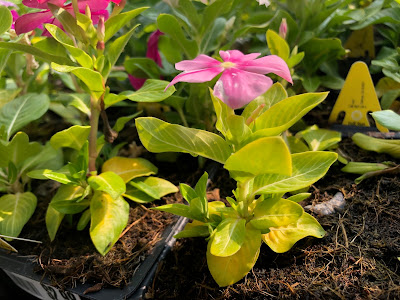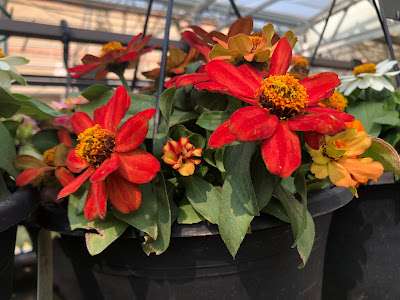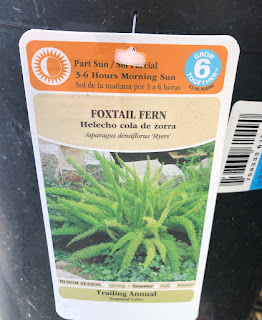
Choose wisely and your garden additions will thrive
The weather's cooler -- hooray! -- and gardeners can return to a favorite sport: Choosing plants to add to the garden this fall.
But before rushing off to the nursery (independent or big-box), there are ways to help ensure those new plants thrive once they're brought home and transplanted.
Missy Gable, director of the statewide UC master gardener program, did a Facebook live program on this topic last year at this time, and I'm indebted to her tips, though I have plenty of my own. (You can watch her on YouTube here . ) Viewing it again recently made me nostalgic: She filmed it at the UC Davis Arboretum Teaching Nursery just before one of the big fall plant sales. Sigh.
1) Have at least a general idea of what you're looking for. Annuals or perennials, in-ground or container, full-sun exposure or full shade? Foundation plant or accent? This will help you focus when you arrive. We all get distracted by pretty plants; having a shopping list or a diagram of the planting area will keep you on task. I'm a sucker for salvia and coneflowers, but I know it, so I try to stay disciplined.

|
|
If you didn't know it was near the end of the season for vincas,
those yellow leaves would be a good signal.
|
3) Look for season-appropriate annuals and edibles. If I have a single most important tip to share here, it's this: Just because a plant is on sale at a nursery doesn't mean it's right for our climate or the current season. Nurseries are businesses, after all. The good ones make good choices, but they don't have curators on staff to review every plant.

|
|
Just say no to Profusion zinnias in September.
|
4) Don't forget to read the tag. This will tell you how big the plant is supposed to get, and its water and sun requirements. Also, is it an annual or perennial? I'm sometimes surprised to see a plant I'd consider a perennial labeled an annual.
Read the fine print, or look for more information via smartphone, and there's

|
|
An annual, really? This tag was on a
5-gallon pot -- awfully big to be an annual. Turns out it's a perennial in zones 9-11. |
5) Check the roots. Both Missy Gable in the video and Sacramento County master gardener Pam Bone in her various presentations stress this. Don't be afraid to gently ease the plant out of the pot to check, or even stick your fingers in the container to feel around. A plant with curling roots, particularly a woody shrub or tree, will have a much harder time getting established. It may be impossible, in fact, and the plant will die later, at some expense. Smaller shrubs or annuals can often be saved by fluffing up or cutting apart the roots that have become matted in the container. But if you have a choice, pick the plant with healthy, white, unmatted roots.
6) Once those plants are home, tend to them closely until they're in the ground (or a new pot) and established. After all, they've been getting daily water and fertilizer, what Gable call "fertigation." That goes for drought-tolerant plants, too. She has this great comment: "No plant is low-water when you first get it." If you can't get to planting immediately (I'm guilty of this), put it in a protected spot, out of direct sun, and keep it watered until you can transplant it.
If you missed my post from a few weeks ago on local online resources for fall planting, you can find it here .
Comments
0 comments have been posted.Sacramento Digs Gardening to your inbox.
Food in My Back Yard Series
April 29: What's (already) wrong with my tomato plants?
April 22: Should you stock up on fertilizer? (Yes!)
April 15: Grow culinary herbs in containers
April 8: When to plant summer vegetables
April 1: Don't be fooled by these garden myths
March 25: Fertilizer tips: How to 'feed' your vegetables for healthy growth
March 18: Time to give vegetable seedlings some more space
March 11: Ways to win the fight against weeds
March 4: Potatoes from the garden
Feb. 25: Plant a fruit tree now -- for later
Feb. 18: How to squeeze more food into less space
Feb. 11: When to plant? Consider staggering your transplants
Feb. 4: Starting in seed starting
Sites We Like
Garden Checklist for week of May 4
Enjoy this spring weather – and get gardening!
* Plant, plant, plant! It’s prime planting season in the Sacramento area. Time to set out those tomato transplants along with peppers and eggplants. Pinch off any flowers on new transplants to make them concentrate on establishing roots instead of setting premature fruit.
* Direct-seed melons, cucumbers, summer squash, corn, radishes, pumpkins and annual herbs such as basil.
* Harvest cabbage, lettuce, peas and green onions.
* In the flower garden, direct-seed sunflowers, cosmos, salvia, zinnias, marigolds, celosia and asters. (You also can transplant seedlings for many of the same flowers.)
* Plant dahlia tubers. Other perennials to set out include verbena, coreopsis, coneflower and astilbe.
* Transplant petunias, marigolds and perennial flowers such as astilbe, columbine, coneflowers, coreopsis, dahlias, rudbeckia and verbena.
* Keep an eye out for slugs, snails, earwigs and aphids that want to dine on tender new growth.
* Feed summer bloomers with a balanced fertilizer.
* For continued bloom, cut off spent flowers on roses as well as other flowering plants.
* Add mulch to the garden to maintain moisture. Mulch also cuts down on weeds. But don’t let it mound around the stems or trunks of trees or shrubs. Leave about a 6-inch to 1-foot circle to avoid crown rot or other problems.